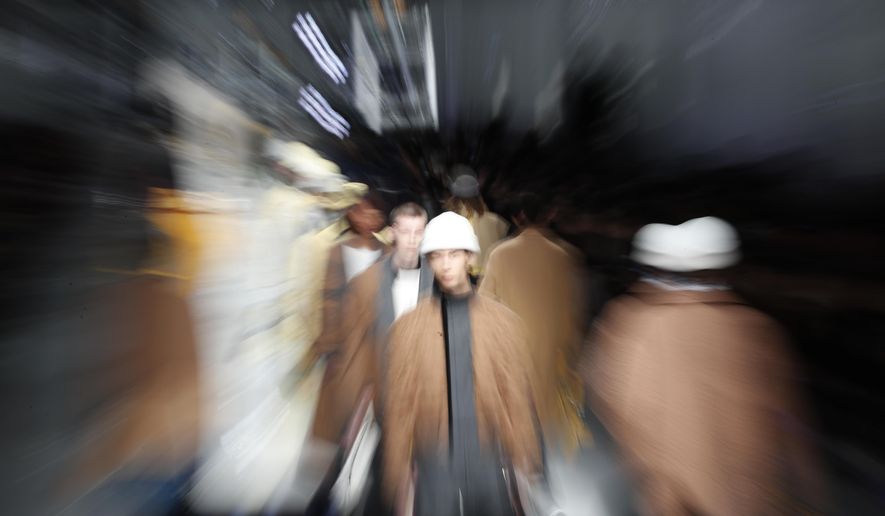MILAN (AP) - Milan designers continued their exploration of the shifting roles and representations of men in changing times.
The design language during Milan Fashion Week veered from androgyny to gender-less to hybrid - but always against a backdrop of unmistakable masculinity, just enough elements to turn the feminine heat up or down. The overall trend was toward more formality, but that can be broadly defined and not just as suits. In fact, business suits with ties were few and far between on Milan runways, while jackets took on an array of shapes beyond the traditional notched lapel or double-breasted looks.
In the celebrity role call, Golden Globe-winning actors Taron Egerton and Stellan Skarsgard sat front row at Armani, and Jude Law’s daughter, Iris, and Australian singer Cody Simpson attended Fendi.
Highlights of Monday’s shows on the fourth day of Milan Fashion Week previews of mostly menswear looks for Fall/Winter 2020/21:
—-
FENDI HITS HYBRID NOTE
Silvia Venturini Fendi presented a rich collection for the family-run fashion house that subtly blurred gender lines, without ever abandoning a masculine silhouette. The collection hit just the right note in the conversation of what men’s dressing can be today.
The art lay foremost in the overcoats, which were tailored in three lengths that zipped on and off, depending on the mood or weather. The coats appeared in three-tone fur or wool, changing with each removable panel. In their most cropped version, the coats swung sensually like short capes with shortened sleeves. That could be layered over a V-neck ribbed sweater and high-waist jersey gray trousers.
Men’s suits featured slightly larger lapels, and were paired with knitwear, including soft sweaters with generous turtlenecks that could be pulled over the head for extra protection against the elements. Knickerbockers sometimes substituted trousers.
Chains were the motif of the season, encoding the brand’s Double-F logo in oval formations. They appeared as fur intarsia in soothing shades of mint green, steel blue and yellow, as well as on necklaces and eyewear chains.
A series of Fendi-emblazoned bags in bright yellow were the accessories of choice; especially tantalizing were eye-catching leather shopper bags that could be mistaken for their in-store brethren. They were complemented by matching rectangular suitcases, tiny boxes and small airpod cases.
The same yellow popped out on big-knit scarves with Fendi naively stitched on, suiting and suede jacket and a big pillow-y puffer jacket. Footwear included knee-high leather waders, a favorite of the season, and sneakers
Fur- and knit-trimmed caps and bucket hats in warm, rich fur finished the looks. The Fendi man does not shy away from earrings.
FABIO QUARANTA’S NEW UNIVERSE
Embracing the genderless moment, Fabio Quaranta didn’t label his show as menswear or womenswear; he didn’t even assign a season.
These were clothes for anyone, anytime, “starting from men’s fashion codes, and transcending traditional ideas of gender.”
Jackets were for layering: boxy versions one over the other, or with suit jackets, or with padded vests. Trousers were slightly cropped and wide cut, good for men and women in bold plaids. There were also Bermuda shorts - a definite Milan winter trend, and perhaps a comment on the apparent inevitability of global warming?
Quaranta, who is celebrating the 10th anniversary of his brand, also put crew-neck knitwear over suits jackets, the tails peeking out at the bottom, and feminized a blazer with a thin belt for her.
‘’I don’t think formal is a coat and tie. I think formal is when you are at ease from morning to night,’’ Quaranta said backstage. ‘’Formal and informal can be the same thing, depending on how you wear it, who you are.’’
Quaranta’s suits were based on one made by tailors for the late Fiat scion Edoardo Agnelli, who never picked it up. And in a sustainability play, acid green and yellow uniforms - a boxy jacket and matching trouser - were made from bedspreads from a former summer camp for the children of workers of the state-controlled ENI oil company.
He dubbed the collection Urania, Italian for Uranus, because “it’s a new universe.”
____
FORMALITY REDEFINED AT ARMANI
It’s definitely winter in Giorgio Armani’s world. Setting the tone, images of snow flurried on screens above the runway, which was set up around plastic sculptures resembling melting ice.
The designer opened the collection with a series of ski and snowboard wear in puffy black or white in a capsule collection dubbed Neve, or Italian for snow. They included puffer shawls wrapped around coats, and zig-zag mohair sweaters under ski vests, and over-the-shoulder detachable cozies for an extra layer of warmth and protection that appeared first on the Emporio Armani runway.
Transitioning into ready-to-wear, Armani made the overcoat the statement piece of the season, with the focus on texture. A wool coat had a nubby boucle finish; a shawl collar added elegance to a suede coat; striped overcoats were meant to recall blankets.
Plaid suits were set off by solid lapels; jackets were relaxed, from Nehru-style to sweater-like coats. The trouser of the season tapered slightly at the cuff.
The color palette was mostly steely neutrals, with departures into rich velvet suits in moss green and royal red set off by Navy blue.
The show ended with six models stopping on the runway for a closer look of black velvet formal wear, while Armani took his bows to celebratory applause.
“Giorgio Armani’s design quest has always expressed the desire to match changing times and needs with the concept of enduring elegance and pertinence,” according to the show notes. The looks were meant to bring ‘”the spirit of formality into the modern day.”




Please read our comment policy before commenting.